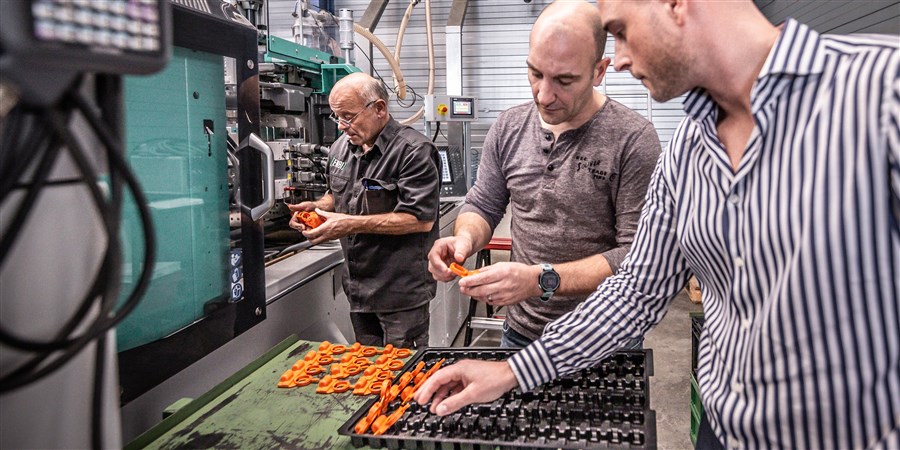Work of nearly half of workers made easier by new technology

In 2021, 90 percent of all workers aged between 15 and 74 reported using technology at work. This means, for example, that they use a computer every day, use digital systems to look up information, or work with advanced technical tools or resources.
In addition to the convenience of new technology, a relatively large share of these workers indicated that these new technologies enable them to process more information and do more work in the same amount of time. A smaller number of workers also feel that this has led to increased monitoring or control at work, or that new technology has made their work more mentally demanding.
| Verandering werk | More (% of workers who use technology) | Less difficult/demanding (% of workers who use technology) | No effect (% of workers who use technology) | Less (% of workers who use technology) | More difficult/demanding (% of workers who use technology) |
|---|---|---|---|---|---|
| Process more or less information | 45.4 | 48.9 | 5.7 | ||
| More or less work the same time | 37.6 | 54.3 | 8.1 | ||
| More or less control over work | 27.5 | 64.1 | 8.4 | ||
| More or less pleasant | 20.3 | 62.3 | 17.4 | ||
| More or less difficult | 47.5 | 38.9 | 13.6 | ||
| More or less physically demanding | 17.7 | 79.6 | 2.7 | ||
| More or less mentally demanding | 12.7 | 64.3 | 23 |
Young workers most likely to say new technology makes their work easier
Younger users of technology are generally more positive regarding the impact of technological developments in their work than older workers. For example, 61 percent of those aged 15 to 25 feel it has made their work easier. Among those aged over 55, that share was 35 percent. According to younger workers, new technology has also made their work more enjoyable, and less physically and mentally demanding.
Older users of technology were more likely than other age groups to report that their work has become more mentally demanding, less fun and more difficult as a result of technological innovation.
| 15-24 yrs (% of workers who use technology) | 25-54 yrs (% of workers who use technology) | 55-64 yrs (% of workers who use technology) | 65-74 yrs (% of workers who use technology) | |
|---|---|---|---|---|
| More difficult | 5.0 | 12.9 | 21.6 | 19.5 |
| Easier | 61.1 | 48.5 | 35.5 | 34.8 |
| More physically demanding | 1.4 | 2.7 | 3.6 | 4.2 |
| Less physically demanding | 28.1 | 17.1 | 12.4 | 13.1 |
| More mentally demanding | 9.7 | 23.5 | 30.8 | 24.4 |
| Less mentally demanding | 20.7 | 12.9 | 7.0 | 6.5 |
| More enjoyable | 21.0 | 21.5 | 16.0 | 17.1 |
| Less enjoyable | 8.8 | 16.7 | 25.4 | 21.6 |
Work in agriculture and hospitality easier due to new technology
Workers in agriculture and the food and accommodation services sector are more likely to report that new technology has made their work easier and less physically demanding. A relatively high number of workers in the manufacturing sector also perceive their work as less physically demanding as a result. Workers in education were the most likely to report that new technology has actually made their work more difficult and more mentally demanding.
Workers in the transportation and warehousing sector were the most likely to say that technological changes had increased monitoring and supervision at work. Workers in agriculture and ICT were the most likely to say that technological advances had made their work more enjoyable. In healthcare, by contrast, new technology is the most likely to have made work less enjoyable.
| Bedrijfstak | Easier (% of workers who use technology) | Less physically demanding (% of workers who use technology) | More enjoyable (% of workers who use technology) |
|---|---|---|---|
| Agriculture, forestry and fishing | 61.8 | 41.1 | 31.6 |
| Food and accommodation services | 57.9 | 23.7 | 19.4 |
| Wholesale and retail | 51.9 | 18.5 | 20.0 |
| Business services/real estate | 51.9 | 15.5 | 23.9 |
| Information and communication | 50.3 | 10.6 | 30.3 |
| Transportation and storage | 48.4 | 19.9 | 18.6 |
| Manufacturing | 48.3 | 24.3 | 23.9 |
| Financial services | 48.0 | 9.0 | 23.7 |
| Construction | 47.5 | 21.9 | 21.8 |
| Culture, sport and recreation/other services | 44.9 | 16.2 | 18.4 |
| Public administration | 43.5 | 12.2 | 19.2 |
| Education | 42.5 | 10.7 | 19.9 |
| Health and social services | 40.5 | 20.4 | 12.8 |
4 in 10 perceive safer working conditions
Users of technology who work with advanced technical devices (such as robots, drones, exo-skeletons, or self-driving vehicles) were also asked what impact this has had on safety at work. Of this group, 40 percent reported that new technological advances had made work safer. Safety had increased the most in the manufacturing and health & social care sectors.